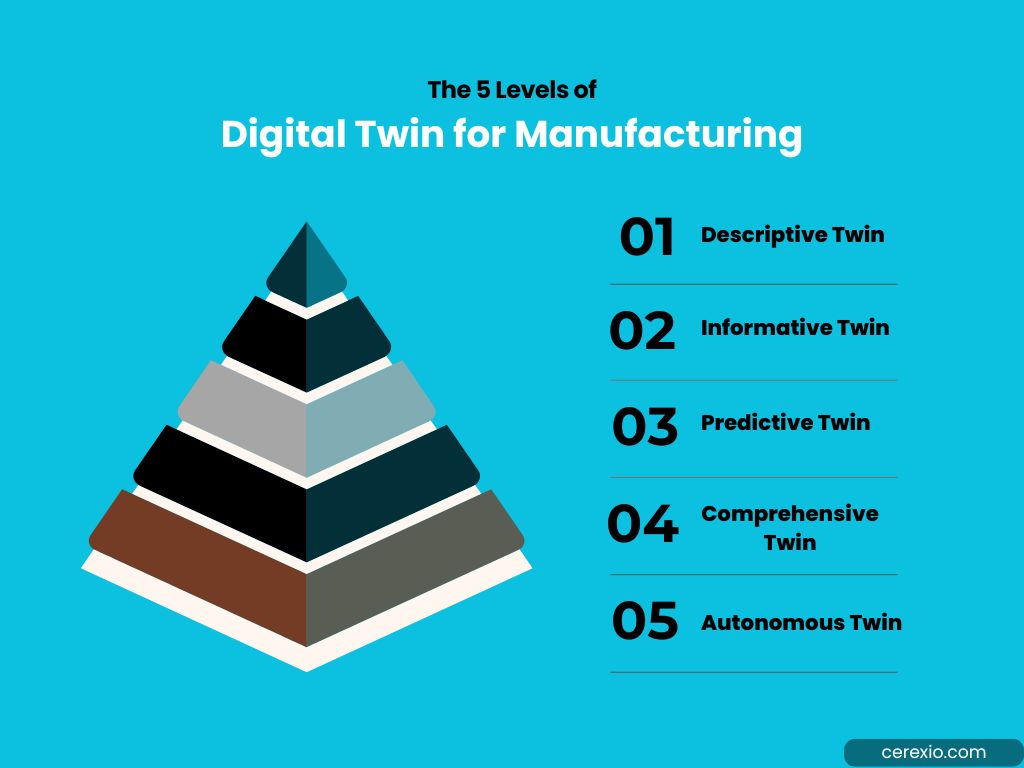In this article, we discover all five levels of Digital Twin, especially for the manufacturing industry.
Why is Digital Twin Important for Manufacturing?

- The main reason is that it creates a virtual model of physical assets, processes, or systems, allowing manufacturers to optimise operations and improve decision-making.
- When simulating real-world scenarios, Digital Twin helps manufacturers identify potential issues before they occur. This will reduce downtime and enhance efficiency beyond doubt. This technology helps monitor equipment performance in real time, providing insights that can lead to predictive maintenance, thus avoiding costly breakdowns.
- Plus, Digital Twin also plays a key role in improving product quality by allowing manufacturers to test and validate products in a virtual environment before actual production. This process reduces errors, shortens development cycles, and ensures products meet required standards. Furthermore, it facilitates better resource management with its ability to optimise the use of materials and energy. This is what leads to more sustainable manufacturing practices.
- Additionally, Digital Twin technology supports integrating advanced technologies like IoT, AI, and machine learning, enabling smarter and more adaptable manufacturing systems. This is why Digital Twin as a full-scale capability needs to have fully-functioning levels throughout the whole system.
Exploring the 5 Levels of Digital Twin for Manufacturing

Descriptive Twin
This level creates a visual replica of a built asset, allowing manufacturers to see a detailed and accurate representation of their physical products or systems. The Descriptive Twin includes all the necessary information about the asset, such as design specifications, materials used, and how the product was built.
This way, users can customise the Descriptive Twin by specifying what kind of information they want to include, such as technical details or performance metrics, and what kind of data they want to extract, like production efficiency or material usage. This level helps manufacturers understand how an asset functions in real-time by providing an up-to-date visual model.
Also, this model allows them to analyse different aspects of the manufacturing process, make adjustments, and improve the overall efficiency of their operations. The Descriptive Twin supports better decision-making by offering a clear and accurate picture of how things work, which helps in identifying potential problems before they occur.
Informative Twin
This level goes beyond just replicating the design and manufacturing details. It also gathers and combines data from various sensors and operational systems. This data includes information such as temperature, pressure, speed, and other key metrics that impact the manufacturing process. The Informative Twin continuously collects this real-time data and integrates it into the digital model, creating a more dynamic and accurate representation of the physical asset.
Since it allows for capturing and aggregating this defined data, the Informative Twin helps manufacturers monitor how different parts of the system work together. This level verifies the data to ensure that all systems are functioning correctly and harmoniously.
Predictive Twin
This sort of plays a transformative role in the manufacturing landscape as it can employ operational data to provide powerful insights. This level of the Digital Twin does not just replicate the physical asset or gather real-time data, yet it goes a step further by analysing this data to predict future outcomes.
The Predictive Twin continuously monitors the manufacturing process, using historical and current data to identify patterns and trends. By doing this, it can foresee potential issues before they occur, such as equipment failures or production bottlenecks. This predictive capability allows manufacturers to take proactive steps to address problems, minimising downtime and reducing costs associated with unexpected disruptions.
So, as you can see, this approach not only enhances efficiency but also extends the lifespan of equipment.
Comprehensive Twin
This is mainly because it enables advanced simulation of future scenarios. This level allows manufacturers to explore ‘what-if’ questions and analyse how different variables will impact the production process and overall operations.
If you are confused between the Predictive Twin and the Descriptive Twin, you should know that these two are completely different. When it comes to Predictive Twin, it focuses on forecasting based on existing data. However, Comprehensive Twin dives deeper into potential outcomes by simulating various future scenarios.
Manufacturers can use this tool to test the effects of changes before implementing them in the real world. For example, a manufacturer might want to know how switching to a new supplier or altering a production method could affect efficiency, costs, and product quality. The Comprehensive Twin allows them to simulate these changes in a virtual environment, providing insights without the risk of disrupting actual operations.
This simulation capability makes the Comprehensive Twin particularly valuable for strategic planning and decision-making.
Autonomous Twin
This means the Autonomous Twin can monitor and control production processes, identify and correct issues, and optimise operations in real time. For example, if the twin detects a problem with a machine, it can automatically adjust settings or shut down the equipment to prevent damage, all without waiting for human input. This level of autonomy not only increases efficiency but also significantly reduces the likelihood of human error, leading to more consistent and reliable production outcomes.
Now let us elaborate on its mechanism. The learning aspect of the Autonomous Twin is key to its functionality. Since it continuously analyses data from the manufacturing process, it improves its decision-making abilities over time. This learning helps the twin to adapt to changes in the manufacturing environment, such as shifts in demand or the introduction of new technologies. Ultimately, this will ensure that operations remain optimised even as conditions evolve.
Cerexio Digital Twin-Powered Solutions for Manufacturing

Cerexio Digital Twin-powered Software Solutions empower manufacturers with their capacity to provide real-time insights, predictive analytics, and autonomous decision-making. These tools optimise operations, enhance efficiency, and reduce downtime, making Cerexio the ideal destination for manufacturers seeking to stay competitive and innovative in today’s fast-paced market. With Cerexio, you certainly can transform your operations and achieve unparalleled performance.
Empowering Productions via Digital Twin's capabilities

You must admit that the transformative power of Digital Twin technology is undeniable. It contributes to the manufacturing realm by offering unmatched precision, predictive insights, and operational agility. Using such strength, manufacturers can achieve significant competitive advantages by integrating these capabilities into their processes.

